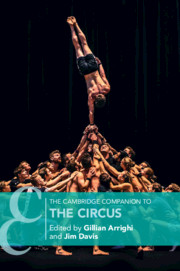Book contents
- The Cambridge Companion to the Circus
- Cambridge Companions to Theatre and Performance
- The Cambridge Companion to the Circus
- Copyright page
- Contents
- Figures
- Contributors
- Acknowledgements
- Timeline
- Introduction
- Part I Transnational Geographies of the Modern Circus
- Part II Circus Acts and Aesthetics
- Part III Circus
- Part IV Circus Studies Scholarship
- Bibliography
- Index
Introduction
The Circus: Reflecting and Mediating the World
Published online by Cambridge University Press: 22 June 2021
- The Cambridge Companion to the Circus
- Cambridge Companions to Theatre and Performance
- The Cambridge Companion to the Circus
- Copyright page
- Contents
- Figures
- Contributors
- Acknowledgements
- Timeline
- Introduction
- Part I Transnational Geographies of the Modern Circus
- Part II Circus Acts and Aesthetics
- Part III Circus
- Part IV Circus Studies Scholarship
- Bibliography
- Index
Summary
In 2018 we marked the 250th anniversary of the founding of the modern circus, an event traced to the entrepreneurial initiatives of Philip Astley (1742–1814). Astley enclosed a circle of ground on the south side of the Thames in 1768 where he exhibited his unusual equestrian skills for a paying public. The circus’s specialised history in different parts of the globe reveals that for just over 250 years this hybrid entertainment, with its own codes of physical and comic performance, visuality, and business management, has developed and diversified through multiple cycles of reinvention. Oscillating through phases of illegitimacy on the fringes of society and validation for its aesthetic and entertainment appeal, the circus’s restless evolution has always been influenced by unique confluences of the political environment, artistic heritage, and aesthetic trends particular to its geographic context.
- Type
- Chapter
- Information
- The Cambridge Companion to the Circus , pp. 1 - 16Publisher: Cambridge University PressPrint publication year: 2021
- 1
- Cited by

